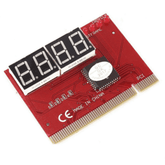Peltier Cooler: Working Principle & Applications
Introduction
Exploring the blog will provide insights into the fascinating realm of electronic cooling solutions, with a focus on the peltier module working principles. It works by transferring energy between two metals through electrical current and can be used to maintain desired temperatures without any moving parts. This makes it both extremely efficient and reliable for applications requiring precise temperature control such as data centers, medical research facilities, industrial production environments and more. Additionally this device requires very little maintenance because there are no mechanical components involved which reduces downtime during operation making them highly cost effective solutions for many industries today!
What is a Peltier Cooler
A Peltier Module is an electronic component that helps to counter Thermal Issues in a Circuit. Many Circuit components might require a cool environment to operate, while others might need to maintain a certain temperature and not above or below it, to operate effectively. Here Heat Sinks and Cooler Fans might not work due to architecture, hence Peltier Modules comes to the rescue, by solving the problem at hand as well as maintaining the Architecture.
The Peltier Module Working Principle
Understanding the intricate details of the peltier module working is crucial. In the Peltier Cooler, two ceramic plates separated by semiconductor pellets create a dynamic interplay as current flows through, leading to heat dissipation and absorption.

REF: CUI devices
Peltier module working on the principle of the Peltier Effect. This effect brings up a temperature difference by transferring heat between two junctions. The Principal application of the Peltier Module is Cooling, but this module can also be used for heating or maintaining a temperature.
For example: Imagine a Peltier module installed in a portable beverage cooler. Inside the cooler, there are two ceramic plates separated by semiconductor pellets. When electricity is supplied to the module, the semiconductor pellets on one side absorb heat from the inside of the cooler, causing that side's ceramic plate to cool down. Meanwhile, the other side's ceramic plate dissipates the absorbed heat to the outside environment, keeping the beverages inside cool. This demonstrates the Peltier Module working principle, where heat is transferred between the two junctions to maintain a temperature difference.
HeatSink and Cooling
Ensuring the efficiency of the peltier module working requires the use of proper heat sinks. The Peltier cools one side and heats the other, emphasizing the importance of effective heat dissipation. Due to excessive heat on one side of the Peltier, the module might melt or may get internally damaged, thus A heat sink will sap the heat from the Peltier surface and keep it functioning and undamaged.
In addition to the Heat Sink one can even use a cooling fan to keep the Peltier from overheating, cooling fans come in various sizes, if bigger cooling fans hinder your design, you can look up small cooling fans to maintain the structure of your project and keep it from being bulky.
Heat Sinks and Cooling Fans avoid the Peltier from Overheating and help keep the environment of your Hardware safe from adverse effects of Peltier Cooling.
Note on the Appropriate Power Supply to use with a Peltier.
A Peltier Chip Power Supply Depends on the Peltier Chip you are using. Based on the General Usage A Peltier Approximately consumes 60 watts of Power. Thus the Maximum Voltage you can supply based on this Rating is 15 Volts with a 6 Amp of current, thus using any power supply that can provide you the same can be used.
Things to keep in mind while using a Peltier.
When Selecting a Peltier Module for implementation in the project, it is very important to know what does the Datasheet of the Peltier in Hand says.
A Peltier Data sheet Normally consists of the following terms on the 1st page
1.Hot Side Temperature
2.Q max
3. Delta Tmax
4.Imax
5.Vmax
6.Module Resistance
It is important for the user to not exceed Imax and Vmax levels while operating the Module.
One should always Consult HB for moisture protection options
There is also a Failure rate and Life Expectancy of a Module that is specified in the datasheet which shall be noted to get insightful information about the module.
Avoid Peltier Damage:
The current and voltage rating of the Peltier should be kept at the maximum value but this value should not be exceeded as it might be the major reason for the Peltier being damaged.
Many people tend to increase the current through the Peltier to increase cooling which is justified but only to a certain extent. The current through Peltier is proportion to the Cooling, but the heat generated inside the module is proportional to the square of the current, so after a certain point of time, if the current increases too much, even if it is within the safety margin, the square relation may overpower the linear relation and the Peltier might get damaged.
Secondly, Applying mechanical pressure on the Peltier Cooler might develop fractures inside the module that may harm the Peltier’s Functioning.
Applications of Peltier
A cooling module like Peltier has numerous Applications as it can act as the backbone of many Electronic Processes.
- Mini Refrigerators: As a small Electronic Project, a Peltier can be used to make mini Refrigerators that can even make Ice.
- Ophthalmic Lasers: Inside Ophthalmic Lasers, Peltier is used to keeping the laser diodes below a certain temperature, and cool the Crystals.
- Night Vision Devices: To avoid image noise, image sensors are cooled using the Peltier
- Battery Cooling of Electric Cars: One can use Peltiers to Cool Li-IOn batteries of Electric Cars
- cryopreservation: We can use Peltier to preserve tissues, cells, and other similar substances in cool temperatures that are cooled using Peltiers
Conclusion:
In conclusion, delving into the peltier module working reveals a reliable and efficient solution for precise temperature control without relying on mechanical components. Understanding Peltier Module working principles and employing proper cooling strategies are crucial for optimal performance and longevity. With diverse applications spanning from data centers to electric cars, the Peltier Cooler continues to drive innovation in thermal management, shaping the future of electronic systems.






